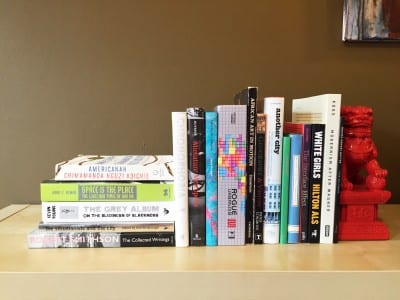It’s funny how picking (curating?) some books and taking a photograph of them with a cute piece of CB2 kitsch allows for a long view of one’s trajectory. At first I thought these 17 books illustrated the issues that have animated the research and writing of my project on mapping and a small group of African and Afro-Atlantic artists. Art and time, art and space, art and information, and art and cities are all concerns raised in this book. As I looked closely, I realized that this group is also relevant to my nascent research on the city of Dakar, Senegal. Here, I have long been interested in what art, architecture, and popular culture reveal about human experiences of urban space, and how such things change over time. In this way, these books represent more than research directions: they show the primary parts of my intellectual project, one that has been animated not only by art and architectural history but also urbanism, information studies, mapping, networks, and the inheritance of modern art and modernism in Africa and its diasporas.
This shelf reveals the conversations that push my work. Its genesis is in research and writing, in reading other books, and in interactions with artists and their work. Artists Mark Bradford, Houston Conwill, and Julie Mehretu’s work led to a consideration of the politics of mapping and urban space as well as geography and vision, which are also remnants of my former existence as a designer who specialized in making information graphics. Their work led me to books on time and art, and, along with Renée Green’s projects, the writings of Robert Smithson. María Magdalena Campos-Pons and Moshekwa Langa’s artwork led to a study of memory, networks, and artmaking. All of these artists, along with Coco Fusco, Renée Green, and William Pope.L, made me think about “storying,” so eloquently detailed in Kevin Young’s essays. This list emanates from conversations with friends and colleagues (and from sneaking a peek at their bookshelves while visiting them). It is the result of my interest in writing and in telling stories about architecture, art, cities, and human experience. And it comes from my pleasure in reading and love of writing. Novels and books of essays help in the search for ways to imaginatively fashion my own writing.
This list is also a self-portrait. This is what I look like today. I would have looked different last week, last month, or last year. I will look different next week.
My Reading List:
Chimamanda Ngozi Adiche, Americanah (New York: Anchor Books, 2014)
Hilton Als, White Girls (San Francisco: McSweeney’s, 2014)
Denis E. Cosgrove, Geography and Vision: Seeing, Imagining and Representing the World (London: I.B. Tauris, 2008)
Anne Fadiman, At Large and At Small: Familiar Essays (New York: Farrar, Straus and Giroux, 2007)
Jack Flam, ed., Robert Smithson: The Collected Writings (Berkeley: University of California Press, 1996)
Alexander R. Galloway, The Interface Effect (Cambridge: Polity Press, 2012)
David Joselit, After Art (Princeton, NJ: Princeton University Press, 2013)
Andreas Huyssen, Miniature Metropolis: Literature in the Age of Photography and Film (Cambridge, MA: Harvard University Press, 2015)
Juliet Koss, Modernism After Wagner (Minneapolis: University of Minnesota Press, 2010)
Laura Kurgan, Close Up at a Distance: Mapping, Technology and Politics (New York: Zone Books, 2013)
Pamela M. Lee, Chronophobia: On Time in the Art of the 1960s (Cambridge, MA: The MIT Press, 2004)
Tom McDonough, ed., The Situationists and the City (New York: Verso, 1999)
Edgar Pieterse and AbdouMaliq Simone, eds., Rogue Urbanism: Emergent African Cities (Auckland Park, South Africa: Jacana Media, 2013)
Lisa Saltzman, Making Memory Matter: Strategies of Remembrance in Contemporary Art (Chicago: University of Chicago Press, 2006)
John F. Szwed, Space is the Place: The Lives and Times of Sun Ra (Boston: Da Capo Press, 1998)
Robert Farris Thompson, African Art in Motion: Icon and Act in the Collection of Katherine Coryton White (Berkeley: University of California Press, 1974)
Dell Upton, Another City: Urban Life and Urban Spaces in the New American Republic (New Haven: Yale University Press, 2008)
Kevin Young, The Grey Album: On the Blackness of Blackness (Minneapolis: Graywolf Press, 2012)
Steven Nelson, professor of African and African American art history at the University of California, Los Angeles and director of UCLA’s James S. Coleman African Studies Center, is currently treasurer of the National Committee for the History of Art, and chair of the advisory board for the National Gallery’s Center for Advanced Visual Study. Nelson is also a reviews editor for the Journal of the Society of Architectural Historians and a contributing editor to Grove Art Online. His 2007 book From Cameroon to Paris: Mousgoum Architecture In and Out of Africa has received multiple awards, and he has published widely on the contemporary and historic arts, architecture and urbanism of Africa, African American art history, and queer studies. Nelson is currently completing two books, “Structural Adjustment: Mapping, Geography, and the Visual Cultures of Blackness,” and “On the Underground Railroad.” He was Art Journal reviews editor from 1999 to 2004. He dreams of writing a collection of familiar essays on art and architecture.


